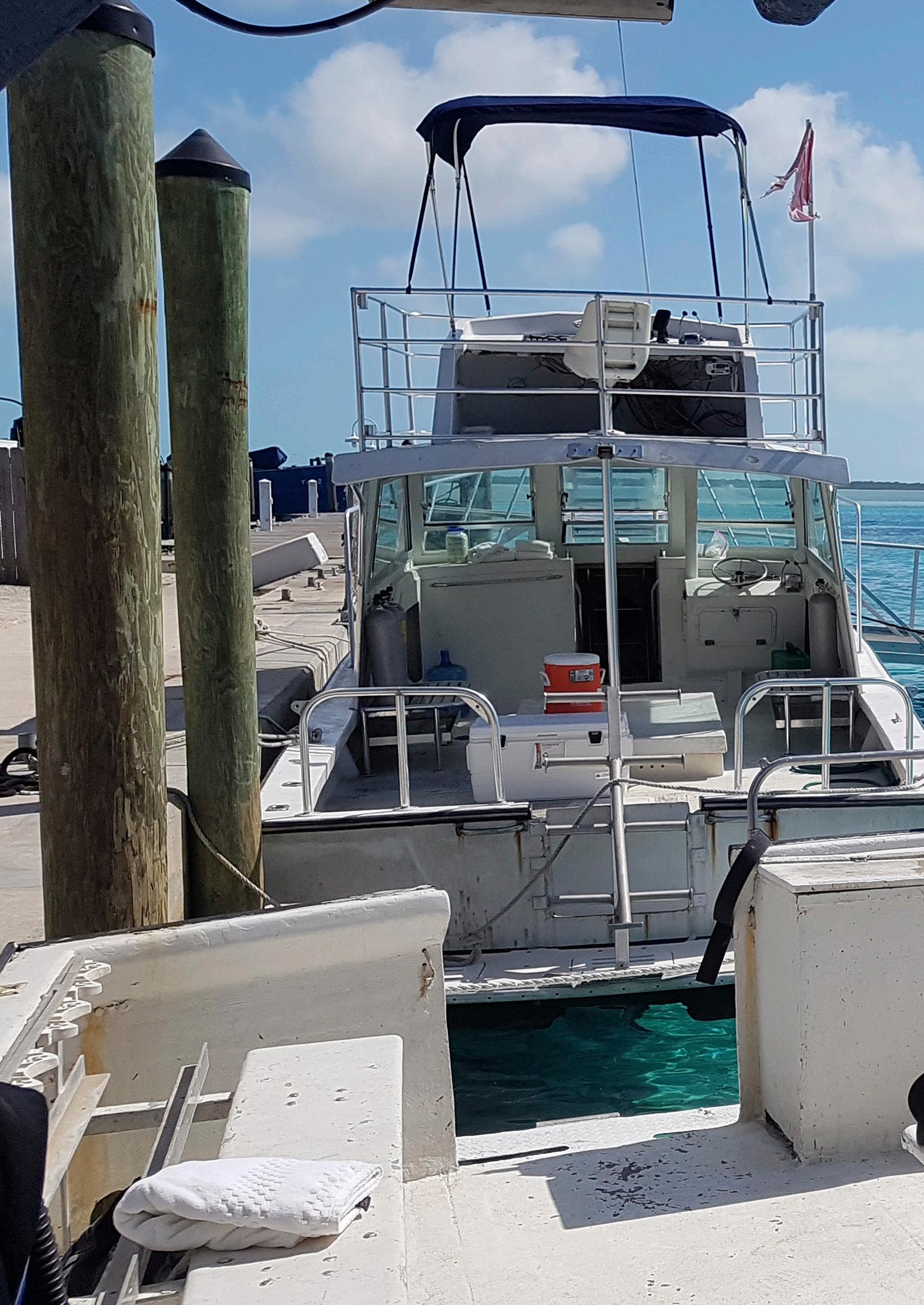
14 minute read
The Adventures of a UAE Diver: The Magnificent Sharks of the Bahamas
FEATURE AND PHOTOGRAPHY SARAH MESSER

Advertisement
At the end of my last article in the EDA March magazine issue, I was musing over the year ahead. I had dedicated my 2020 diving trips to a year of sharks – travelling to new salty locations to seek out sharks I’d not yet seen. By the time the magazine had hit our inboxes, I had booked a trip to the Maldives in March and a trip to Sipidan, Malaysia that I should have been flying to as I write this article…
Ho-hum. 2020 had other plans for us.

Little did I know at the time, how grateful I would be today for the call I received from my boss at the end of January. Boss: “What have you got in your diary mid-Feb? Can you cancel it? I need you at a conference in Miami”. Me: thinking quickly – got a lot on in Feb, some big deadlines. Ooh Miami, never been there. OH MIAMI, DIVING… “Well I can probably clear some stuff and make it, OK”, whilst with the other hand already looking for flights.
I immediately set about googling diving near Miami, and spent some time reading about sites in and around Florida Quays. Then I looked at a map to see where some of them are located, and I saw just how close the Bahamas is. YIKES! A few more searches later, I realise the islands are just a 45 minute flight from Fort Lauderdale airport, and boom. The first decision is made. Bahamas here I come!
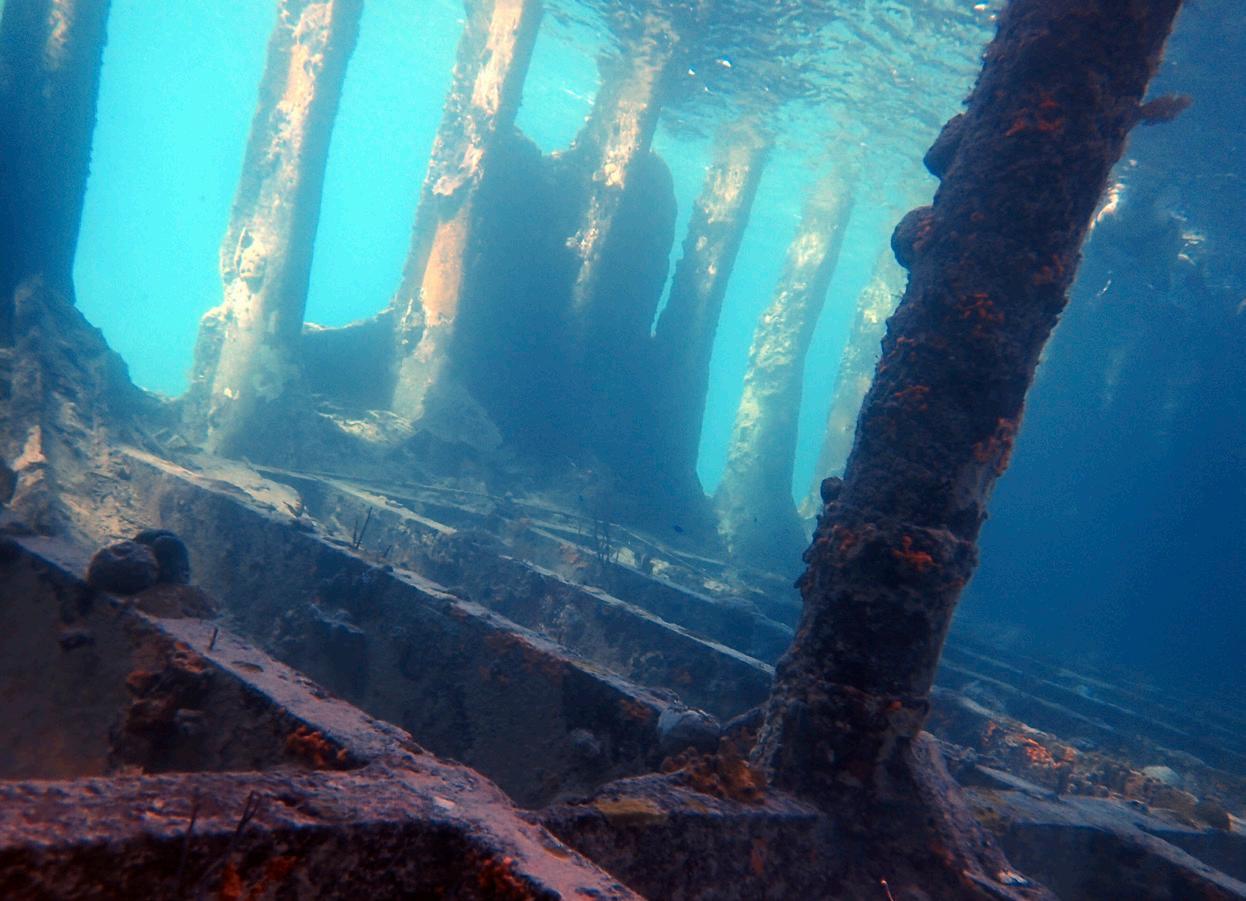
THE BAHAMAS – A SHARK MECCA
The Bahamas is part of the Caribbean, and consists of a chain of islands spread out over some 800 kilometres in the Atlantic Ocean, to the east of Florida, north of Cuba, and west of the Turks and Caicos Islands. Some 700 islands and over 2,000 rocks and cays (of which 30 are inhabited) make up the Bahamas to a total land area of 3,860 square miles.

Around 60% of the Bahamas is underwater, which combined with year round warm temperatures and a tropical climate, makes for an endless supply of spectacular dive sites. The archipelago is an ecological oasis, boasting some of the cleanest, clearest water on the planet. And with conditions like these above and below the ocean, the marine diversity is flourishing. The Bahamas have such wide ranging diversity that there’s something for every type of diver, from vibrant healthy coral reefs, to the world’s second deepest blue hole, a plethora of large and small marine life, and many ship and plane wrecks. The type of diving you want to do then dictates the Bahamian island you will head to.
But back to the sharks. Shark populations in the Bahamas, because of the protected and tropical conditions, are thriving. Any diving enthusiast will know the area is famous for some of the best shark diving in the world. The most common breeds to be found here are Lemon sharks, Blacktips, and the Caribbean Reef sharks, but there are plenty of others to be found too. Divers seeking a shark experience are more likely to be looking for the Whitetip, Bull, Tiger or Great Hammerhead sharks.

TO BAIT OR NOT TO BAIT
Many of the shark dives you will see in the Bahamas involve shark baiting, a controversial topic. Many of the most influential shark conservationists today are comfortable with shark baiting that is conducted properly, with respect, and has the wellbeing of the shark populations firmly at the core ofthe activities. The crux of this must be:
• Shark behaviour is not changed – sharks are predators that play a crucial role in keeping smaller fish populations in check. They should not be fed so much that they do not hunt anymore.
• All sharks are wild, and only people who really understand their behaviour and how to be around them should be feeding them. We are in their territory and need to respect that at all times.
• Conservation is a core part of the activities, it is not just a tourist exercise. The best dive centres will be working with local marine biologists and scientists to improve our understanding of shark behaviour with the aim to protect them.
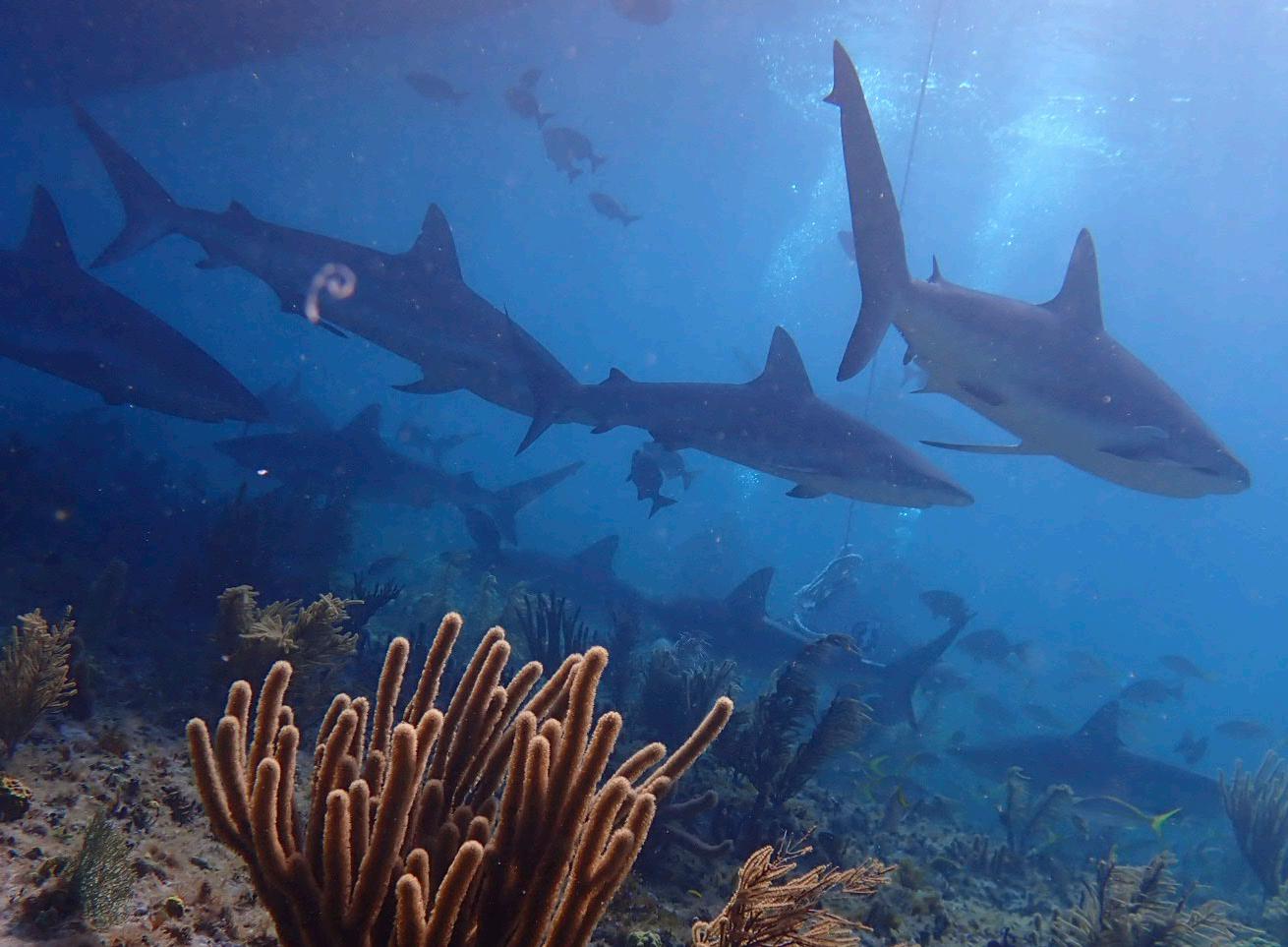
CHOICES, CHOICES, CHOICES
I now needed to choose which island to go to and at this point two were jumping out at me: Grand Bahama to visit Tiger Beach (unsurprisingly well known for its Tiger sharks), or Bimini to dive with the Great Hammerheads. I kid you not, this decision took over my life for 2 days. How could I choose between these amazing experiences? I dreamt about sharks for those 2 nights. In the end, it was my schedule that answered the question for me (mustn’t forget I still need to go to that work conference…).
Both Freeport on Grand Bahama and Bimini islands are available by ferry or direct flight from Fort Lauderdale. Grand Bahama is a little bit further away, and so as I had limited time, I chose to go to Bimini. Plus there were other dives available so I could see more than just the Hammers.
Bimini is the westernmost district of the Bahamas and comprises 3 small islands in a chain, located about 80 kilometres east of Miami. The largest islands are North Bimini and South Bimini; the latter houses an airstrip. From South Bimini, you take a short minibus ride 5 minutes from the terminal to the ferry (which is more of a large zodiac than a passenger ferry), which takes you to your hotel destination.
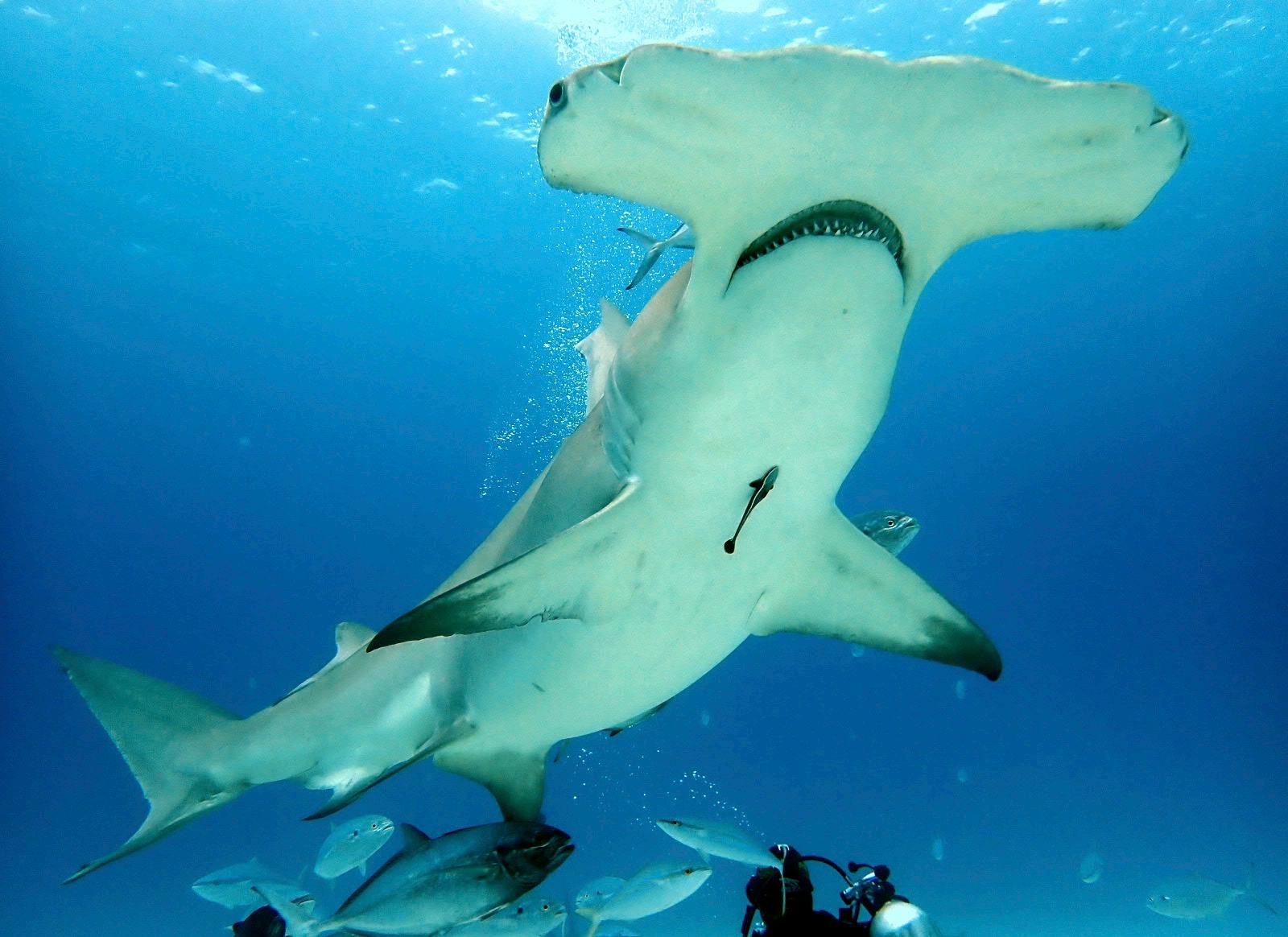
THE BLUEST BLUE
As I left the port, it was a beautiful warm bright sunny day. What immediately struck me, was the beauty of the shimmering turquoise ocean, stretching out as far as I could see, the kind of blue you don’t believe exists until you actually see it for yourself. And the water was so supremely clear that at times it seemed like there wasn’t any water underneath you at all.
The stories and legends that swirl around the history of Bimini only adds to its charm. Known as Ernest Hemingway’s favourite escape, Bimini is historically significant as a rum trading post during the prohibition years. You’ll be told stories by the locals of Bimini Road, which they believe is a remnant of the legendary Lost City of Atlantis.
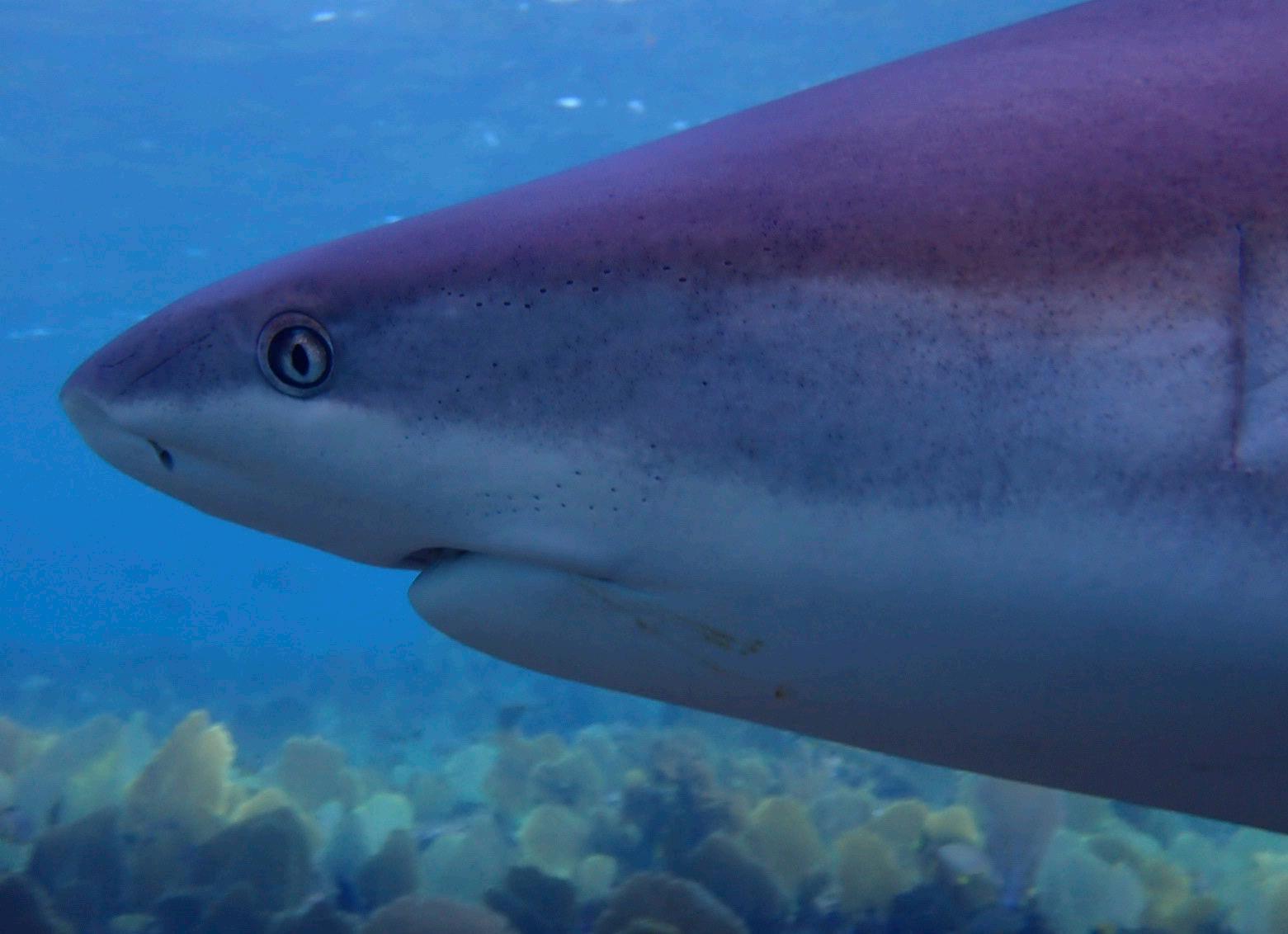
That tingle of happiness and anticipation that you get when you know you’re on an epic diving adventure starts…
I chose to stay at the Hilton Resorts World, which wouldn’t have been my first choice, preferring the less ‘big-chain’ accommodation offered close to the dive centres, but as a late booker I had to take what was on offer. Not to do the hotel any disservice, it is beautiful with great rooms and customer service as you would expect from any Hilton.
The trip from Dubai was 24 hours in total, so on arrival I was happy to do nothing for the rest of the day so I could rest and be ready for my dives the next day.
DIVE CENTRES
There are 2 dive centres operating from North Bimini island (I was staying on the South island, they are very easy to get between with a 10 min car or golf buggy ride); Neal Watson’s Bimini Scuba Center, located at Bimini Big Game Club (a hotel), and Bimini Undersea Dive Center. Both had excellent reviews. I chose Neal Watson for 2 reasons; they were mentioned multiple times on the scuba forums I read with many returning divers, and I could clearly see their commitment to shark conservation through their work. Take note – if you don’t book in advance, its likely you won’t get the dives you want, they are very popular especially in peak season, with limited space.
S.S. SAPONA AND REEF SHARKS
Day 1 started with a shipwreck called Sapona. The S.S. Sapona has a chequered history. She was one of a fleet of concrete ships built to serve as troop transport during WWI because steel was in short supply. This ship is said to have been designed by Henry Ford himself.
Because the ship was completed after the end of the war, the Sapona was never used for what she was intended and was sold for scrap to a developer. She was then briefly used as a casino, then for oil storage, and eventually as a floating warehouse to store and distribute liquor supply during the Prohibition Era. In 1926 the ship ran aground in a hurricane and was then used as a bombing target for training by U.S. fighter planes during World War II. However, after a group offive torpedo bombers mysteriously disappeared while returning from a run in 1945, all target practice on the Sapona stopped immediately – and the legend of the Bermuda Triangle was born.
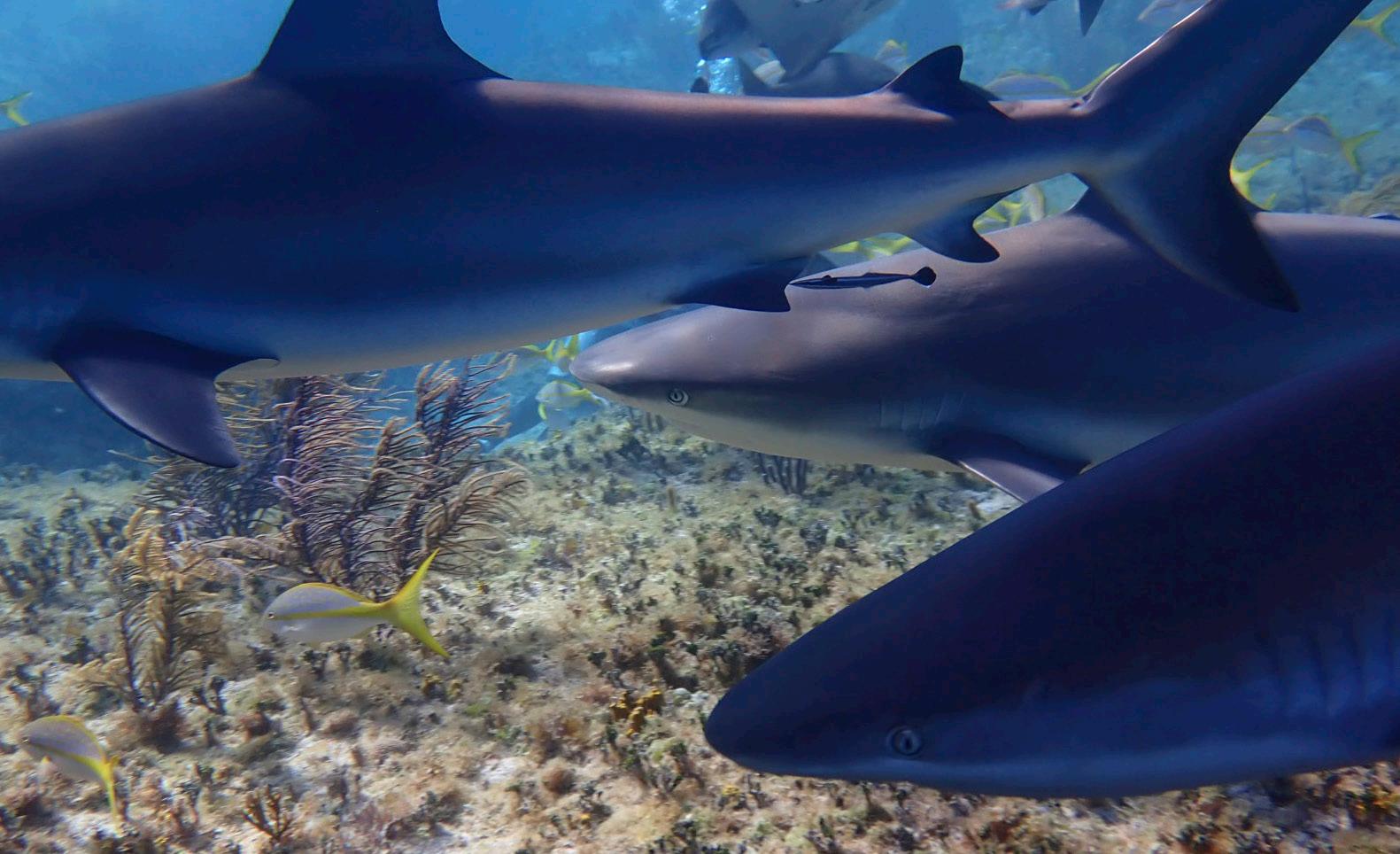
The wreck sits in just 15 feet of water and you can see the effects of the bombing clearly on the dive. I was there at low tide, on occasions I was snorkelling more than diving, but that doesn’t take away from the charm of the story or the reef that has grown over the base of the ship.
The best was still to come though, the Reef sharks.This was my first baited dive and I was unsure what to expect. The crew gave very clear instructions about the dive and how we should behave, there was no ambiguity. We were told there would likely be several Reef sharks with us, and sure enough we could see them swimming around the boat during the briefing. We would descend to about 12 metres as the sharks remain near the surface, and rest on the bottom to watch them. It was less of a dive and more of a weighted sinking –in order to not float around and remain still, all divers are kitted up with at least 25 kg of weights.
We descended on a line slowly to the magnificent sight of 10+ adult Reef sharks swimming around us. At this point the boat had lowered a sealed chum box off the back, so it was dangling between the bottom of the boat and the ocean floor. The smell of the chum inside (chunks of fish heads and tails) kept them swimming all around us; up and down, around and around. These were by far the biggest sharks I had ever seen up close; the bigger adults were not much smaller than me. And yet they were not frightening. They were not aggressive or defensive. They could sense we were no danger to them and we don’t smell or look like food. Once I was comfortable with them, I could move around a bit to get closer and see them from different angles. A really magical hour surrounded by grace and majestic beauty.
Once everyone is back on deck, the bait box is pulled out of the water and emptied into the ocean. And then you realise why they didn’t do that with us in the water, as the sharks thrash about over each other to get to the chum.
THE GREAT HAMMERHEADS
Day 2 was the one I had been waiting for, the Great Hammerheads. On paper these creatures are something to behold, and I was excited and nervous to see what one would like in real life. The Hammers I have seen before in Egypt were between 1-1.5 metres long. Great Hammers can be up to 6 metres (20 feet) long, and on average 3.5 metres. They also weigh an average of 230 kg. These sharks are not to be messed with.
The Great Hammerhead can be distinguished from other Hammerheads by the shape of its “hammer” (called a cephalofoil) which is wide with an almost straight front margin.The first dorsal fin is also very distinctive, being very tall and strongly sickle-shaped. All of its fins are unusually large which sadly has meant it is highly prized by hunters wanting to fin them for sale in Asia. As a result this species is now critically endangered. They have almost no predators, other than humans, and can prey themselves on other sharks as big as the Reef sharks I had seen the day before.
Again, we were given a very clear briefing from the dive guides. Twice. There could be no mistaking or misinterpreting the instructions. It’s clear from the delivery that this dive has freaked divers out before, and no one wants a panicked diver. Every diver has 2 tanks and the maximum dive time is 1 hour. The feeder goes in first with the bait box and to fix a line. It will be a shallow dive again (12 metres) and again we’re weighted up to the max so that we can rest on the sandy bottom without flailing limbs.

With only 10 people on the dive, we get into the water one at a time and quickly descend on the rope, forming a semi-circle around the feeder, the bait box in the middle of us. If the Reef sharks were majestic in their graceful movements, these enormous female Great Hammerheads just emanate power and strength as they glide through the water. They are beautiful!
We settle back onto our heels, and the guides have a routine to make sure everyone can enjoy every position and angle. I had 5 Great Hammers on my dive, circling us and coming in for the bait. The feeder is careful not to let them knock the box away, and slowly takes out one piece of chum at a time when he can see a shark heading towards him. They come from the front, fast, making a beeline for the food with their mouths open. The feeder knows exactly when to let go of the bait so the shark grabs it and swoops right over our heads or across the front of us, and swims away behind and around in a big circle so she can come in for more, just as another giant beauty is taking her snack.
One after the other, swim, snatch, swoosh, swim, snatch, swoosh. Sometimes 2 come in at the same time, and you can see the pecking order as one shark backs away. They come so close you can count their teeth. They swoop so close over you, their fins graze your sleeve or head. No aggression, no defensiveness. Occasionally one slows down enough to pause and look you in the eye, and for a moment, a split second, you have a connection with a shark 3 times your size and 100 times more powerful, and in that moment you understand each other.
You can feel their intelligence and their curiosity. They know we come in peace, and mainly they want their fish head to eat. You can see the relationship that the feeders and guides have with the Hammers – they know them somehow, they see each other every day, they’ve gotten to know each other’s personalities. There’s a deep respect and love I can see clearly from the feeders for these creatures. And boy do they know how to handle them, there is almost playful wrestling going on between man and beast. It’s incredible to watch and be a part of.
There is no doubt that to some degree the baiting has changed the sharks a little, but having seen it for myself, I can see it is not done in a damaging way. These titbits they are given are mere morsels, a mouthful for a creature that size. They still need to hunt as much as if they did not have the bait. They are certainly not tame, they are still wild animals, but they have learned that the humans that come in every day are not a threat and that they will get a ‘treat’. Kind of like a cat, but 210 kg of cat with 3 razor sharp layers of teeth. Not your average pet. And with these daily meetings, the shark biologists have been able to tag and monitor their behaviours over the years to see their migration, feeding and birthing patterns. With that knowledge, they can help this species survive humans in the long term.
Would I do it again? In a heartbeat. These were incredibly magical dives, and I feel humbled to have been able to get up close and personal with these magnificent sharks –both the Reefs and the Hammers. I don’t yet know how many sharks I will fit into 2020, but I am so grateful that I got to see these sharks before lockdown began 3 weeks later. Until next time, stay home and safe buddies.
THE DIVE CENTRES
NEAL WATSON’S BIMINI SCUBA CENTER: www.biminiscubacenter.com
BIMINI UNDER SEA DIVE CENTER: www.biminiundersea.net










